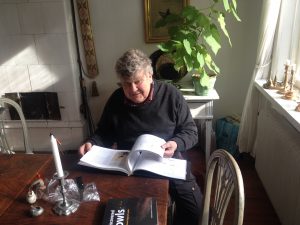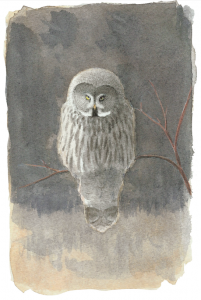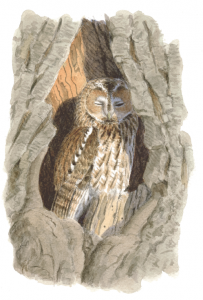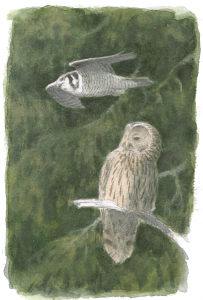Meet the illustrator – Håkan Delin
The first I (Magnus) remember hearing about Håkan Delin was Mark and Killian haggling over his artwork. When OUP offered the original artwork of BWP (The birds of the Western Palearctic, Cramp 1985) for sale, Killian advised Mark to snap up any owl plates he could get. These had been painted by Håkan, and Killian considered them the finest artwork in BWP. In return for the original of one of his best Collins Bird Guide (Svensson et al 2009) plates, Killian was delighted to secure one of them from Mark.
Years later I was surprised to learn that BWP was the first book Håkan had ever illustrated. Before he retired, Håkan worked as a head paediatrician in a hospital in Stockholm, which left him very little time for birding or painting. In fact, during the 13 months when he painted those owls for BWP, he slept an average of just four hours per night. I suspect he has never been an excessive sleeper, which is one of the reasons why he knows so much about owls.
 Håkan Delin seeing his illustrations in Undiscovered owls for the first time, Stockholm, April 2015. Magnus Robb & The Sound Approach
Håkan Delin seeing his illustrations in Undiscovered owls for the first time, Stockholm, April 2015. Magnus Robb & The Sound Approach
I have had the privilege of owling with Håkan on several occasions now. He is a very careful listener, despite having lost his hearing in one ear when he was in his 40s. Like me, Håkan will go out of his way to hear a sound described by somebody else, if he has not yet heard it himself. He is an excellent mimic. When Håkan does Ural Owl Strix uralensis, he almost becomes one. More often than not, there is an immediate response. A few days ago in the Swedish mountains, we wanted to pay our respects to a pair said to live near our youth hostel. While we waited, I set up a mic near a hooting Long-eared Owl Asio otus. On this occasion no Ural showed up, but immediately after Håkan’s first imitation the Long-eared moved to the far side of its territory and stayed there for the rest of the night. In the past, many more birders must have had this ability than now, but it would take a careful listener to imitate as well as Håkan.
Håkan is imitating a Ural Owl Strix uralensis when some migrating Eurasian Curlews Numenius arquata show up, so he whistles to them instead.” Möklinta, Uppland, Sweden, 17 April 2012. Magnus Robb & The Sound Approach.
Although Håkan likes to see rarities as much as any birder, it’s not what motivates him most. The subject of Håkan’s collection is memories, not species. A vivid new experience with a Snowy Owl Bubo scandiacus or Gyr Falcon Falco rusticolus would mean much more to him than a new tick for his Swedish list. He is a prolific writer of notes, often with sketches, but needs neither of these to recount in fantastic detail some of his most exciting observations from half a century ago.
If pressed, Håkan could probably put a date and location for most illustrations in Undiscovered owls, although most have been refined through repeat observations. Only two are sketches from the time; the rest are from long-term memory. Håkan doesn’t copy photos, although he does use them to check things. Working from memory also ensures that he paints scenes that are more meaningful for him, moments when he learned something for the first time, or when events conspired to make the occasion more memorable. The results reveal not only a great eye for detail – a Tawny Owl Strix aluco in a tree cavity, its face partly in shadow, the eye in the shadow open, the one in the sunlight closed, or a Lapland Owl Strix lapponica with one side of the facial disc higher than the other – they illustrate the owls plus the chord they struck, and it is this additional, undefinable layer that helps to fix the images in our minds too.
Håkan is a modest man. He avoids the limelight, and you are not likely to find him with us at a bird fair or a book presentation. It’s just not his natural habitat. Despite this, he has been ‘discovered’ several times. A young Lars Svensson, a few years his junior, was so impressed by his field skills that Håkan became his mentor. Later, they wrote a field guide together (Bruun et al, 1986, Delin & Svensson 2007), and I’m sure more than a few of Håkan’s original observations will have made their way into the Collin’s Guide. I consider myself very fortunate that Håkan has become a friend and mentor to me too.
References
Bruun, B, Delin, H, Singer, A, Svensson, L & Zetterström, D 1986. Country Life guide: Birds of Britain and Europe. London.
Cramp, S (editor) 1985. The birds of the Western Palearctic 4. Oxford.
Delin & Svensson, 2007 Philip’s Guide to Birds of Britain and Europe. London.
Svensson, L, Grant, P J, Mullarney, K & Zetterström, D 2009. Collins bird guide. Second edition. London.


